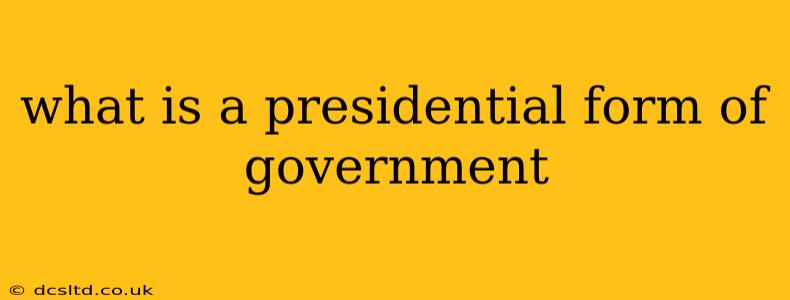A presidential form of government is a system where the head of state and head of government are the same person—the president. Unlike parliamentary systems where the executive branch (prime minister and cabinet) is drawn from and accountable to the legislature, in a presidential system, the executive branch is separate and independent from the legislative branch. This separation of powers is a defining characteristic and forms the bedrock of checks and balances intended to prevent tyranny and ensure accountability.
This article delves into the key features of a presidential system, addressing common questions and exploring its strengths and weaknesses.
What are the Key Features of a Presidential System?
Several key features distinguish a presidential system:
-
Separation of Powers: The executive, legislative, and judicial branches operate independently. The president, elected separately from the legislature, cannot be easily removed by the legislature (except through impeachment). The legislature, in turn, cannot dissolve the executive branch. This separation creates a system of checks and balances.
-
Fixed Terms: Presidents serve for a predetermined term, typically four or five years, regardless of legislative confidence. This provides stability and predictability, preventing frequent changes in leadership.
-
Direct Election: Usually, the president is directly elected by the people, either through a simple majority or an electoral college system (as in the United States). This ensures popular legitimacy and accountability to the electorate.
-
Independent Executive: The president appoints their cabinet, which is responsible to the president, not the legislature. This allows for a more unified and decisive executive branch.
-
Veto Power: Presidents often possess the power to veto legislation passed by the legislature, further enforcing the separation of powers and enabling a check on legislative actions.
-
Impeachment: While the president cannot be easily removed by the legislature, mechanisms for impeachment exist in most presidential systems for serious misconduct. Impeachment processes are typically complex and require significant legislative support.
What are the Advantages of a Presidential System?
- Stability: The fixed terms prevent the instability often associated with parliamentary systems where governments can fall quickly.
- Strong Executive: A directly elected president often enjoys strong popular mandate and can implement policies effectively.
- Checks and Balances: The separation of powers prevents concentration of power in a single branch.
- Accountability: Direct election increases presidential accountability to the people.
What are the Disadvantages of a Presidential System?
- Gridlock: The separation of powers can lead to political gridlock if the president and legislature are controlled by different parties.
- Inefficiency: Decision-making can be slow and cumbersome due to the need for compromise and consensus.
- Executive Dominance: A powerful president might overshadow the other branches of government.
- Risk of Instability: Impeachment processes, while offering accountability, can also create political instability if misused or overly frequent.
How Does a Presidential System Differ from a Parliamentary System?
The core difference lies in the relationship between the executive and the legislature. In a parliamentary system, the executive (prime minister and cabinet) is drawn from and accountable to the legislature. A vote of no confidence can remove the executive. In a presidential system, the executive is independent of the legislature, with a separate election and fixed term.
What are Some Examples of Countries with Presidential Systems?
Many countries utilize presidential systems, including the United States, Brazil, Mexico, India, South Korea, and many others. However, the specific details and power dynamics within these systems can vary considerably.
What are the Potential Pitfalls of a Presidential System?
While presidential systems offer advantages, certain pitfalls need careful consideration:
- Authoritarianism: A powerful president could potentially exploit weaknesses in the system to consolidate power, eroding democratic norms.
- Polarization: Strong partisanship can lead to significant political polarization and gridlock.
- Lack of Flexibility: The fixed terms and separation of powers can make it difficult to adapt to rapidly changing circumstances.
By understanding the key features, advantages, and disadvantages of a presidential form of government, one can better appreciate its complexities and implications for political stability, efficiency, and accountability. The effectiveness of a presidential system depends heavily on the specific context, political culture, and the strength of democratic institutions.
